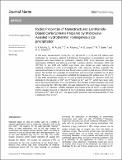Files in this item
Redox properties of nanostructured lanthanide-doped ceria spheres prepared by microwave assisted hydrothermal homogeneous co-precipitation
Item metadata
| dc.contributor.author | Munoz, Fernando Francisco | |
| dc.contributor.author | Acuna, Leandro Marcelo | |
| dc.contributor.author | Albornoz, Cecilia | |
| dc.contributor.author | Leyva, Ana Gabriela | |
| dc.contributor.author | Baker, R.T. | |
| dc.contributor.author | Fuentes, Rodolfo Oscar | |
| dc.date.accessioned | 2015-10-23T23:11:22Z | |
| dc.date.available | 2015-10-23T23:11:22Z | |
| dc.date.issued | 2015-01-07 | |
| dc.identifier | 157456224 | |
| dc.identifier | d0498663-5a08-403e-a796-de9071231698 | |
| dc.identifier | 84920045332 | |
| dc.identifier | 000346919200028 | |
| dc.identifier.citation | Munoz , F F , Acuna , L M , Albornoz , C , Leyva , A G , Baker , R T & Fuentes , R O 2015 , ' Redox properties of nanostructured lanthanide-doped ceria spheres prepared by microwave assisted hydrothermal homogeneous co-precipitation ' , Nanoscale , vol. 7 , no. 1 , pp. 271-281 . https://doi.org/10.1039/C4NR05630B | en |
| dc.identifier.issn | 2040-3364 | |
| dc.identifier.other | Bibtex: urn:e99193e6c8b17c5d7e00ea030497ba57 | |
| dc.identifier.other | ORCID: /0000-0002-3304-3280/work/59464821 | |
| dc.identifier.uri | https://hdl.handle.net/10023/7685 | |
| dc.description | This work has been supported by: the Brazilian Synchrotron Light Laboratory (LNLS, Brazil), under proposals D04BXAFS1-13435 and D12A-XRD1-13437. AgenciaNacional de PromociónCientífica y Tecnológica (Argentina, PICT 2012-1506). | en |
| dc.description.abstract | In this work, nanostructured LnxCe1−xO2−δ (Ln: Gd and Pr; x = 0.1 and 0.2) spheres were synthesized by microwave assisted hydrothermal homogeneous co-precipitation and their properties were characterized by synchrotron radiation XRD, X-ray absorption near-edge spectroscopy (XANES) and scanning and high-resolution electron microscopy (SEM and HRTEM). In situ XRD and XANES experiments were carried out under reducing and oxidizing conditions in order to investigate the redox behaviour of these materials. The nanostructured mixed oxide spheres were found to have a cubic crystal structure (Fm3m space group). The spheres were composed of nanoparticles with an average crystallite size of about 10 nm. The Ln0.1Ce0.9O2−δ compositions exhibited the highest specific surface area (∼60 m2 g−1). In situ XRD experiments showed an increase in lattice parameters upon reduction, which was attributed to the reduction of Ce4+ and Pr4+ cations to Ce3+ and Pr3+, which have larger radii, and to the associated increase in VO concentration. This increase in lattice parameters was considerably more pronounced for PrDC than GDC, and was explained by the considerably larger change in ionic radius for Pr upon reduction. XANES absorption experiments at the Ce and Pr L3-edge showed that the changes observed upon reduction of the Pr-containing samples resulted mostly from the formation of Pr3+ rather than Ce3+, and supported the previously reported proposal that Pr3+ has a stabilizing effect on Ce4+. | |
| dc.format.extent | 1404875 | |
| dc.language.iso | eng | |
| dc.relation.ispartof | Nanoscale | en |
| dc.subject | QD Chemistry | en |
| dc.subject | NDAS | en |
| dc.subject | BDC | en |
| dc.subject.lcc | QD | en |
| dc.title | Redox properties of nanostructured lanthanide-doped ceria spheres prepared by microwave assisted hydrothermal homogeneous co-precipitation | en |
| dc.type | Journal article | en |
| dc.contributor.institution | University of St Andrews. School of Chemistry | en |
| dc.contributor.institution | University of St Andrews. St Andrews Sustainability Institute | en |
| dc.contributor.institution | University of St Andrews. EaSTCHEM | en |
| dc.identifier.doi | 10.1039/C4NR05630B | |
| dc.description.status | Peer reviewed | en |
| dc.date.embargoedUntil | 2015-10-24 |
This item appears in the following Collection(s)
Items in the St Andrews Research Repository are protected by copyright, with all rights reserved, unless otherwise indicated.

